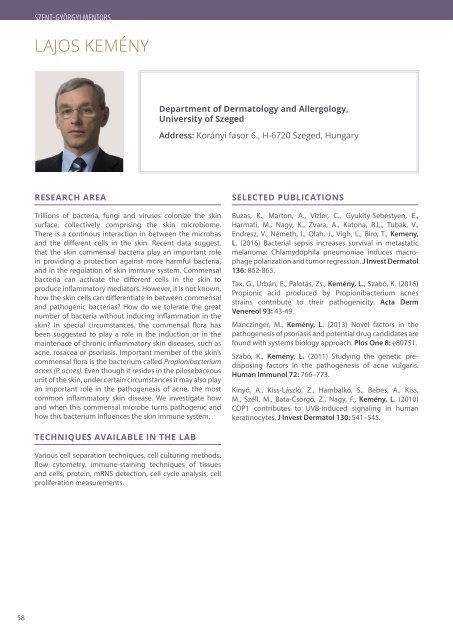Create successful ePaper yourself
Turn your PDF publications into a flip-book with our unique Google optimized e-Paper software.
SZENT-GYÖRGYI MENTORS<br />
LAJOS KEMÉNY<br />
Department of Dermatology and Allergology,<br />
University of Szeged<br />
Address: Korányi fasor 6., H-6720 Szeged, Hungary<br />
RESEARCH AREA<br />
Trillions of bacteria, fungi and viruses colonize the skin<br />
surface, collectively comprising the skin microbiome.<br />
There is a continous interaction in between the microbas<br />
and the different cells in the skin. Recent data suggest,<br />
that the skin commensal bacteria play an important role<br />
in providing a protection against more harmful bacteria,<br />
and in the regulation of skin immune system. Commensal<br />
bacteria can activate the different cells in the skin to<br />
produce inflammatory mediators. However, it is not known,<br />
how the skin cells can differentiate in between commensal<br />
and pathogenic bacterias? How do we tolerate the great<br />
number of bacteria without inducing inflammation in the<br />
skin? In special circumstances, the commensal flora has<br />
been suggested to play a role in the induction or in the<br />
maintenace of chronic inflammatory skin diseases, such as<br />
acne, rosacea or psoriasis. Important member of the skin’s<br />
commensal flora is the bacterium called Propionibacterium<br />
acnes (P. acnes). Even though it resides in the pilosebaceous<br />
unit of the skin, under certain circumstances it may also play<br />
an important role in the pathogenesis of acne, the most<br />
common inflammatory skin disease. We investigate how<br />
and when this commensal microbe turns pathogenic and<br />
how this bacterium influences the skin immune system.<br />
SELECTED PUBLICATIONS<br />
Buzas, K., Marton, A., Vizler, C., Gyukity-Sebestyen, E.,<br />
Harmati, M., Nagy, K., Zvara, A., Katona, R.L., Tubak, V.,<br />
Endresz, V., Németh, I., Olah, J., Vigh, L., Biro, T., Kemeny,<br />
L. (2016) Bacterial sepsis increases survival in metastatic<br />
melanoma: Chlamydophila pneumoniae induces macrophage<br />
polarization and tumor regression. J Invest Dermatol<br />
136: 862-865.<br />
Tax, G., Urbán, E., Palotás, Zs., Kemény, L., Szabó, K. (2016)<br />
Pro pionic acid produced by Propionibacterium acnes<br />
strains contribute to their pathogenicity. Acta Derm<br />
Venereol 93: 43-49.<br />
Manczinger, M., Kemény, L. (2013) Novel factors in the<br />
pathogenesis of psoriasis and potential drug candidates are<br />
found with systems biology approach. Plos One 8: e80751.<br />
Szabó, K., Kemény, L. (2011) Studying the genetic predisposing<br />
factors in the pathogenesis of acne vulgaris.<br />
Human Immunol 72: 766–773.<br />
Kinyó, A., Kiss-László, Z., Hambalkó, S., Bebes, A., Kiss,<br />
M., Széll, M., Bata-Csörgő, Z., Nagy, F., Kemény, L. (2010)<br />
COP1 contributes to UVB-induced signaling in human<br />
keratinocytes. J Invest Dermatol 130: 541–545.<br />
TECHNIQUES AVAILABLE IN THE LAB<br />
Various cell separation techniques, cell culturing methods,<br />
flow cytometry, immune-staining techniques of tissues<br />
and cells, protein, mRNS detection, cell cycle analysis, cell<br />
proliferation measurements.<br />
58












